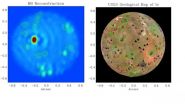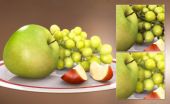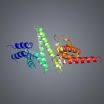(Press-News.org) PITTSBURGH (May 5, 2015) ... For decades, robots have advanced the efficiency of human activity. Typically, however, robots are formed from bulky, stiff materials and require connections to external power sources; these features limit their dexterity and mobility. But what if a new material would allow for development of a "soft robot" that could reconfigure its own shape and move using its own internally generated power?
By developing a new computational model, researchers at the University of Pittsburgh's Swanson School of Engineering have designed a synthetic polymer gel that can utilize internally generated chemical energy to undergo shape-shifting and self-sustained propulsion. Their research, " Designing Dual-functionalized Gels for Self-reconfiguration and Autonomous Motion " (DOI: 10.1038/srep09569), was published April 30th in the journal Scientific Reports, published by Nature.
The authors are Anna C. Balazs, PhD, the Swanson School's Distinguished Professor of Chemical and Petroleum Engineering and the Robert v. d. Luft Professor; and Olga Kuksenok, PhD, Research Associate Professor.
"Movement is a fundamental biological behavior, exhibited by the simplest cell to human beings. It allows organisms to forage for food or flee from prey. But synthetic materials typically don't have the capability for spontaneous mechanical action or the ability to store and use their own energy, factors that enable directed motion" Dr. Balazs said. "Moreover in biology, directed movement involves some form of shape changes, such as the expansion and contraction of muscles. So we asked whether we could mimic these basic interconnected functions in a synthetic system so that it could simultaneously change its shape and move."
As a simple example in nature, Drs. Balazs and Kuksenok use the single-celled organism euglena mutabilis, which processes energy to expand and contract its shape in order to move. To mimic the euglena's mobility, Drs. Balazs and Kuksenok looked to polymer gels containing spirobenzopyran (SP) since these materials can be morphed into different shapes with the use of light, and to Belousov-Zhabotinsky (BZ) gels, a material first fabricated in the late 1990s that not only undergoes periodic pulsations, but also can be driven to move in the presence of light.
"The BZ gel encompasses an internalized chemical reaction so that when you supply reagents, this gel can undergo self-sustained motion," Dr. Kuksenok explains. "Although researchers have previously created polymer chains with both the SP and BZ functionality, this is the first time they were combined to explore the ability of "SP-BZ" gels to change shape and move in response to light."
As Balazs and Kuksenok noted, these systems are distinctive because they not only undergo self-bending or folding, but also self-propelled motion. Namely, the material integrates the powerful attributes of each of the components-the ability of SP-functionalized gels to be "molded" with light and the autonomous mechanical actions of the BZ gels.
According to Dr. Balazs, there were unexpected results during their research. "Uniform light exposure won't work. We had to place the light at the right place in order for the gel to move. And if we change the pattern of the light, the gel displays a tumbling motion.
"We also found that if we placed the SP in certain regions of the BZ gel and exposed this material to light, we could create new types of self-folding behavior." The next phase of the research will be to combine the patterning of the SP and BZ functionality in the gels with the patterning of the light to expand the polymer's repertoire of motion.
Dr. Balazs adds that these SP-BZ gels could enable the creation of small-scale soft robotics for microfluidic devices that can help carry out multi-stage chemical reactions.
"Scientists are interested in designing biomimetic systems that are dissipative - they use energy to perform a function, much like our metabolism allows us to carry out different functions," she explained. "The next push in materials science is to mimic these internal metabolic processes in synthetic materials, and thereby, create man-made materials that take in energy, transform this energy and autonomously perform work, just as in biological systems."
The benefit of using polymer gels instead of metals and alloys to build a robot is that it greatly reduces its mass, improves its potential range of motion and allows for a more "graceful" device.
"To put it simply, in order for a robot to be able to move more autonomously in a more biomimetic way, it's better if it's soft and squishy," Dr. Kuksenok says. "It's ability to grab and carry something isn't impeded by non-flexible, hard edges. You'd also like its energy source incorporated into the design so that it's not carrying that as extra baggage. The SP-BZ gel is pointing us in that direction."
INFORMATION:
Treating gum disease reduced symptoms of prostate inflammation, called prostatitis, report researchers from Case Western Reserve University School of Dental Medicine and the Departments of Urology and Pathology at University Hospitals Case Medical Center.
Previous studies have found a link between gum disease and prostatitis, a disease that inflames the gland that produces semen. Inflammation can make urination difficult.
"This study shows that if we treat the gum disease, it can improve the symptoms of prostatitis and the quality of life for those who have the disease," ...
Although the use of cannabis as a medical drug is currently booming (Dtsch Arztebl Int 2012; 109: 495-501), we should not forget that leisure time consumption--for example, smoking weed--can cause acute and chronic harms. These include panic attacks, impaired coordination of movement, and nausea, as Eva Hoch and colleagues show in a topical review article in Deutsches Ärzteblatt International (Dtsch Arztebl Int 2015; 112: 271-8). The symptoms depend on a patient's age, the amount of the drug consumed, and the frequency of drug use. It also matters in which form the ...
(Winston-Salem, N.C. - May 5, 2015) - Researchers from Wake Forest University and the University of Utah are the first to successfully fabricate halide organic-inorganic hybrid perovskite field-effect transistors and measure their electrical characteristics at room temperature.
"We designed the structure of these field-effect transistors that allowed us to achieve electrostatic gating of these materials and determine directly their electrical properties," said lead author, Oana Jurchescu, an assistant professor of physics at Wake Forest. "Then we fabricated these transistors ...
This news release is available in German.
With the first detailed observations of a lava lake on a moon of Jupiter, the Large Binocular Telescope Observatory in Arizona places itself as the forerunner of the next generation of Extremely Large Telescopes. The applied high-resolution imaging methods were developed by an international research team including scientists from the Max Planck Institute for Radio Astronomy in Bonn and the Max Planck Institute for Astronomy in Heidelberg.
Io, the innermost of the four moons of Jupiter discovered by Galileo in January ...
This news release is available in German.
Overturning cars, flying missiles, and airplanes speeding across the screen -- on modern computers, 3D objects can be calculated in a flash. However, many surfaces still look unnatural. Whether it is skin, stone or wax -- on the computer screen, all materials look alike, as if the objects had all been cut out of the same kind of opaque material. This is about to change: TU Wien (Vienna), the University of Zaragoza and the video game company Activision-Blizzard have developed a new mathematical method which makes surfaces appear ...
Our view of what makes us happy has changed markedly since 1938.
That is the conclusion of the psychologist Sandie McHugh from the Univeristy of Bolton who has recreated a famous study of happiness conducted in Bolton in 1938. She will present her study today, Tuesday 5 May 2015, to the Annual Conference of the British Psychological Society in Liverpool.
In 1938 Mass Observation placed an advertisement in the the Bolton Evening News asking readers to answer the question 'What is happiness?'. A total of 226 people sent letters in reply, and they were asked to help compile ...
Ribosomes are vital to the function of all living cells. Using the genetic information from RNA, these large molecular complexes build proteins by linking amino acids together in a specific order. Scientists have known for more than half a century that these cellular machines are themselves made up of about 80 different proteins, called ribosomal proteins, along with several RNA molecules and that these components are added in a particular sequence to construct new ribosomes, but no one has known the mechanism that controls that process.
Now researchers from Caltech and ...
AUSTIN, Texas -- Researchers in the Cockrell School of Engineering at The University of Texas at Austin have developed a centimeter-accurate GPS-based positioning system that could revolutionize geolocation on virtual reality headsets, cellphones and other technologies, making global positioning and orientation far more precise than what is currently available on a mobile device.
The researchers' new system could allow unmanned aerial vehicles to deliver packages to a specific spot on a consumer's back porch, enable collision avoidance technologies on cars and allow virtual ...
SAN DIEGO, Calif. (May 5, 2015)-- Acceptance of premarital sex is at an all-time high along with an acceptance of homosexuality, find researchers led by Jean M. Twenge from San Diego State University.
The researchers -- also including Ryne Sherman from Florida Atlantic University and Brooke E. Wells from Hunter College -- analyzed data from the General Social Survey, a nationally representative survey of more than 33,000 U.S. adults taken between 1972 and 2012. They found substantial generational shifts in attitudes toward non-marital sex and number of sexual partners. ...
Using proteomics techniques to study injured optic nerves, researchers at Boston Children's Hospital have identified previously unrecognized proteins and pathways involved in nerve regeneration. Adding back one of these proteins--the oncogene c-myc--they achieved unprecedented optic nerve regeneration in mice when combined with two other known strategies. The findings were published online April 30 by the journal Neuron.
Researchers have been trying for many decades to get injured nerves in the brain and spinal cord to regenerate. Various molecules have been targeted ...


